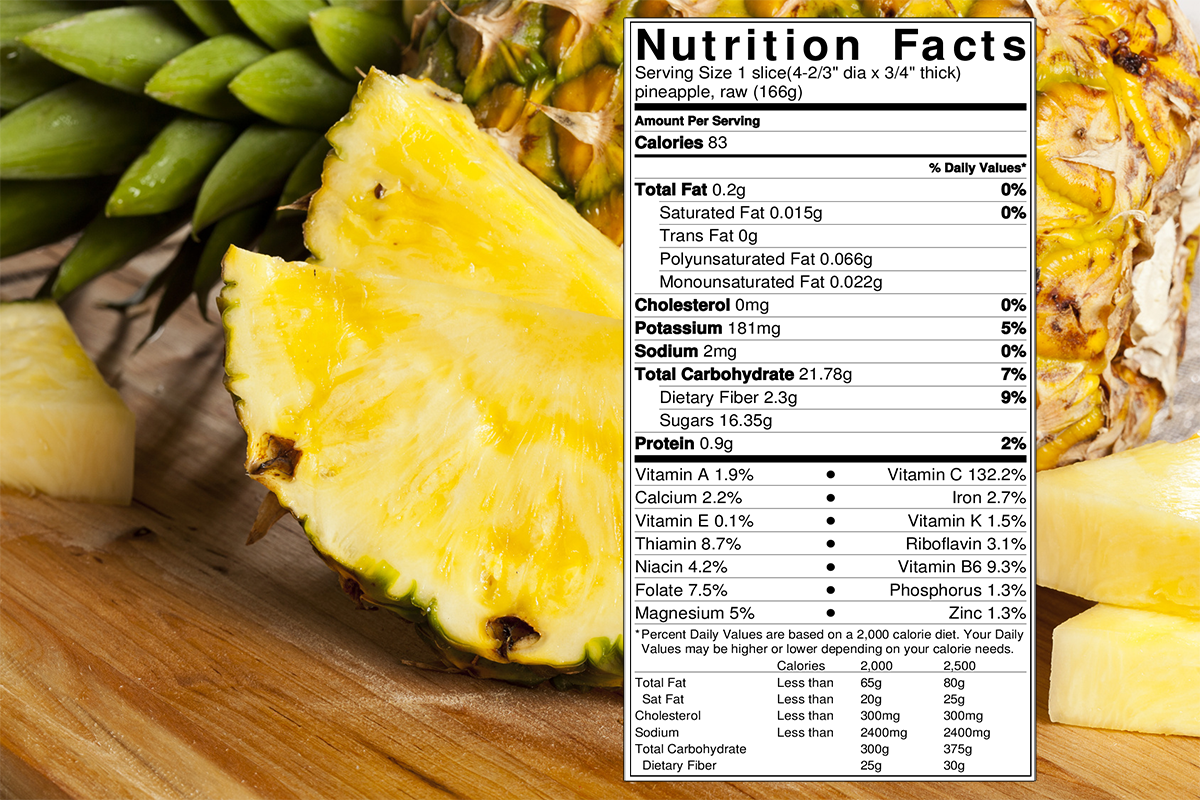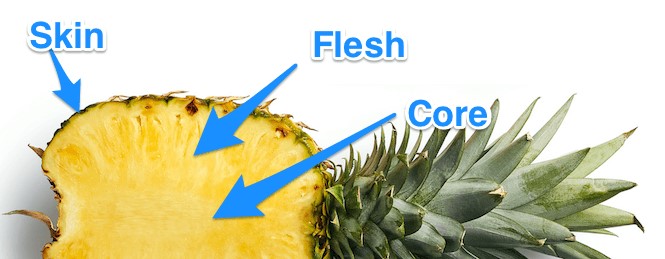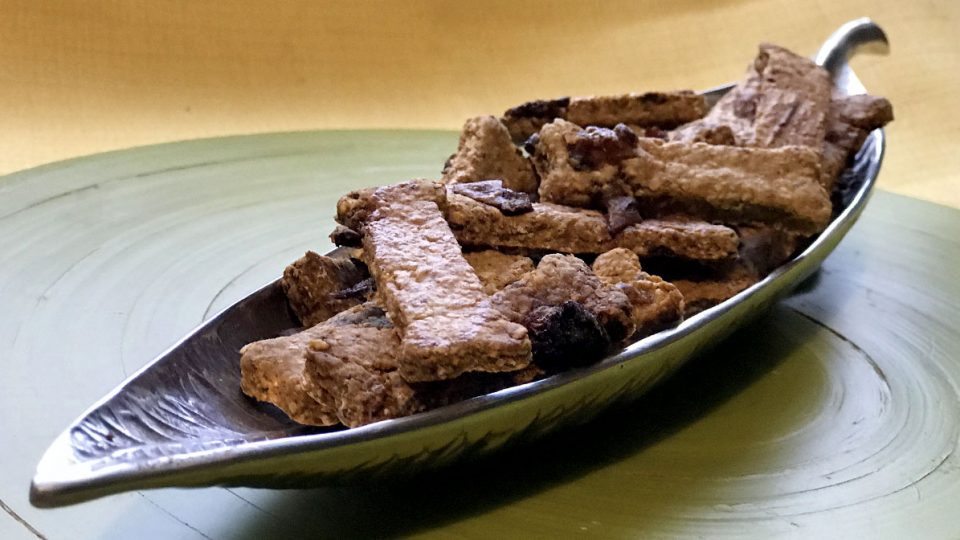Is my dog allowed to eat pineapple?

The answer is YES!
Pineapples can form a delicious treat for your dog.
They contain many vitamins and minerals, and according to the American Kennel Club, they do have a whole lot of thiamine, Vitamin C, riboflavin, folate, and Vitamin B6.
Additionally they contain minerals such as:
- Iron
- Magnesium
- Manganese
- Potassium
- Copper
They also include small but healthy amounts of:
- Phosphorus,
- Zinc
- and Calcium
That’s a big list of health benefits for you and your dog!
Everything in moderation
All of these nutrients help in boosting your dog’s immune system to help keep him perfectly healthy. It is, however, essential to feed him pineapple in moderation. As with anything outside of a regular diet, being excessive can disturb a dogs digestive process and make them sickly.
The fiber content available in pineapples is made of natural sugar which can cause a negative impact on a dogs digestive system if fed in large quantities.
It is therefore vital to keep a close eye on him/her while you feed them pineapple.
The same way you would a child, and this is just to ensure that their system incorporates it in a healthy way. In case he/she experiences an upset stomach or even diarrhea after eating the pineapple, then you should probably discontinue feeding.
The benefits of pineapples for dogs

This island fruit is overflowing with nutritional benefits which aid in various aspects of your dogs health and diet.
Aids the digestive system
The primary enzyme found in pineapples is Bromelain which facilitates the absorption of proteins in the dog’s digestive system. This absorption ability extends to all other nutrients which makes it easy for the dog to take up all sorts of nutrients which aids in their physical health.
May aid in combating cancer-causing cells
Some dog breeds are prone to cancer, interestingly, Bromelain found in pineapples may help in combating these cancer-causing cells. Research data on Bromelain shows that they are capable of shrinking the cancer tumors and reduce swelling in the dog’s joints. They may also reduce pain that is caused by chemotherapy treatment in dogs.
Reduction of inflammation
When a dog is injured or hurt, the area may become inflamed, and this inflammation causes the liver to produce bile that leads to the pancreas. The digestive enzymes in pineapples reduce the offset pancreatitis by decreasing the amount of fat that dogs consume.
Decrease risk of bladder and kidney stones
If you feed your dog foods high in oxalate, it can cause what we call calcium phosphate or calcium oxide stones. These are kidney stones, and they burden a dog by exhausting them physically and causing immense pain. You are also forced to change a dog’s diet as a result of kidney stones formation.
The best option would be to feed a dog food that is low in oxalate, and as a bonus, pineapples are low in oxalate.
Discouraging Coprophagia condition
Coprophagia is a condition when a dog starts to eat his own excrement. It occurs when your precious puppy is not absorbing all of the required nutrients in his body. As a result of this imbalance, the dog starts to act abnormally and eat their poop.
Because of the nature of pineapples – the ability to encourage absorption of healthy nutrients makes pineapples ideal for improving the dog’s digestive system which then eliminates the need for them to feed on unwanted and bacteria-filled fecal matter.
Also, the pineapple makes the dog poop taste bad and become undesirable to the dog. The result will be a dog that does not want even to smell, let alone eat the excrement.
Which parts of a pineapple can dogs eat?

It should be quite evident that you shouldn’t feed your dog the skin or core as they can be dangerous just like they are to humans. The best thing to do is peel it cleanly, remove the core and cut it up into big or small chunks that are easy to eat and digest for the dog.
Just in case your dog comes across a pineapple that has not been peeled, or they happen to eat the peel or the core, they could get lodged in their digestive system and may require surgery to remove, so you should be extra cautious!
Feed him/her small pieces at a time, and during summer, you can make delicious icy treats to keep them cool and hydrated.
Avoid giving canned pineapples because the syrup typically contains a lot of added sugar, which is not particularly healthy for dogs.
How many pineapples can dogs eat in a day?

Since you do not want to make any mistakes when it comes to your dog’s diet, this is a good question.
The ideal amount of pineapple to give your dog is:
- 1 or 2 chucks or pieces of pineapple per day.
You can go as high as 2 to 3 pieces, but bare in mind that this is not the main meal – it is merely a snack. You can also choose to give them as deserts or snacks after or between main meals. The ideal consumption, however, is occasionally.
Can dogs drink pineapple juice?

Pineapple juice is just as healthy as the natural fruit of the pineapple.
The liquid contains all of the necessary vitamins and minerals that help the dog’s immune system and keeps them healthy. Again, remember that moderation is key. DO NOT give too much.
The pineapple juice contains a naturally occurring acid, and if given too much, it can upset the dog’s stomach and cause him to vomit or have diarrhea. Processed pineapple juice, is also not good for your dog because the sugar content is very high and may cause your pet to be sick.
Pineapple dog treats
As mentioned above, you’re welcome to feed your pup fresh pineapple, but she might not take to the taste of it immediately. To combat this, we’ve searched for a delicious and healthy treat you can whip up in your own kitchen. The good news is they’re tasty for humans too!
RECIPE: Pineapple with Tangerine Bits Dog Treats

Ingredients
- 4 Cups rolled oats ground into flour
- 2 Tbsp ground flaxseed
- 4 Tbsp warm water
- 2 Tbsp melted coconut oil
- 1 Cup crushed pineapple
- 1/2 Cup finely chopped dried tangerine (or another dog-friendly dried fruit)
Instructions
- Preheat oven to 350º.
- Put the flax in a small bowl and add warm water, stir, and set aside.
- Grind the oats in the food processor until you get a nice flour consistency. Remove the oat flour to a large bowl and set aside.
- Add the pineapple, flax, and melted coconut oil in a food processor and pulse lightly to combine.
- Add the flour by cupfuls until dough ball forms.
- Transfer the dough ball to your floured work surface. Flatten the ball out with your hands and sprinkle your chopped dried fruit over the top.
- Knead the dough, splitting and folding as necessary to spread the fruit out evenly.
- Roll your dough, adding flour as necessary to keep it workable. Cut out shapes and place onto cookie sheets.
- Bake the cookies for 20 minutes, then pull out, brush with either milk or a beaten egg for some shine, and rotate trays.
- Bake another 20 minutes or until most of the way crisp, then turn off the oven and leave cookies inside to dry out a bit more.
Final thoughts on feeding dogs pineapple

Fresh pineapple is a brilliant source of nutrients for your dog, provided you maintain to only treat them with small quantities in addition to their regular meals.
The high sugar content of pineapple means that huge amounts of pineapple should never be appropriate for your dog’s diet. Whilst small quantities of fresh pineapple are safe for dogs and are a natural anti-inflammatory indulgence, brimming with vitamin C and dietary fiber.

